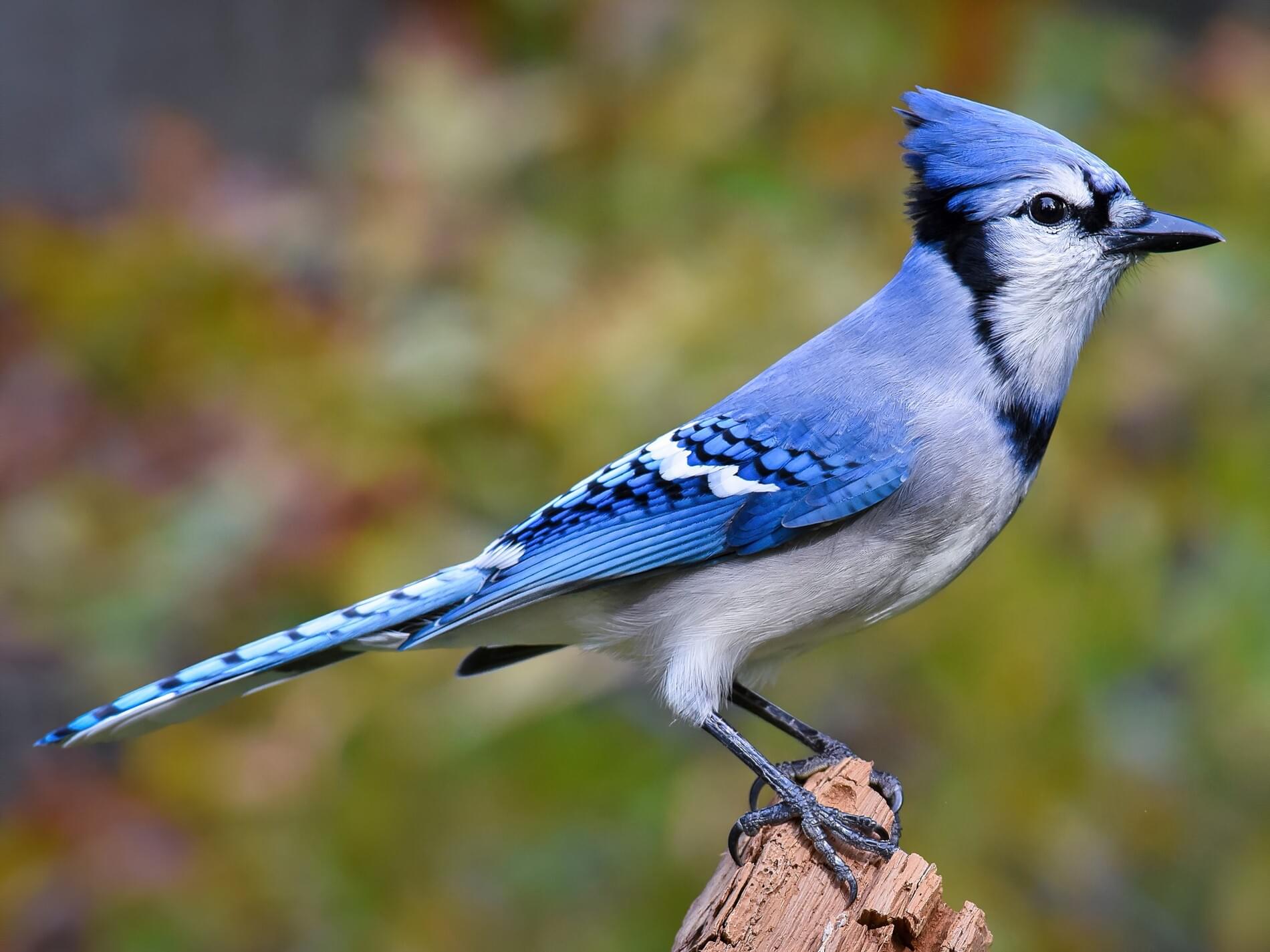Blue Jays in Nature

Blue jays are a vibrant and intelligent species of bird that plays a vital role in North American ecosystems. Their striking plumage, distinctive calls, and fascinating behaviors make them a popular subject of study and observation.
Physical Characteristics
Blue jays are easily recognizable by their bright blue, white, and black plumage. Their bodies are compact and robust, measuring approximately 10-12 inches in length. They have a wingspan of 16-20 inches and weigh around 3-4 ounces. Their beaks are strong and pointed, adapted for cracking seeds and nuts.
Habitat
Blue jays prefer to inhabit deciduous and mixed forests, where they can find ample food sources and nesting sites. They are also found in suburban areas and parks, where they have adapted to living in close proximity to humans. Blue jays are highly adaptable and can thrive in a variety of habitats, as long as there are sufficient food sources and suitable nesting trees.
Role in the Ecosystem
Blue jays are omnivorous birds, feeding on a wide variety of foods, including nuts, seeds, fruits, insects, and small animals. They play an important role in seed dispersal, helping to regenerate forests by caching and forgetting some of the seeds they collect. They also help to control insect populations, consuming large numbers of caterpillars and other insects.
Mating Habits and Raising Young
Blue jays are monogamous birds, forming strong pair bonds that can last for several years. They typically mate in the spring and build their nests in trees, often using abandoned nests of other birds. The female lays 3-6 eggs, which are incubated for about 17 days. Both parents participate in feeding and caring for the young, which typically fledge around 3-4 weeks after hatching.
Blue Jay Behavior: Blue Jays

Blue jays are intelligent and social birds known for their distinctive calls and striking blue plumage. Their behavior is fascinating and complex, showcasing a range of adaptations for survival and communication.
Vocalizations, Blue jays
Blue jays have a diverse repertoire of vocalizations, including calls and songs. They use these sounds to communicate with each other, conveying information about food sources, potential threats, and their social status. Their calls are often described as harsh and raucous, while their songs are more melodious and complex.
- Alarm Calls: When a blue jay senses danger, it emits a loud, piercing alarm call to alert other birds in the area. This call is characterized by a series of rapid, high-pitched notes.
- Food Calls: When a blue jay finds a good source of food, it uses a specific call to attract other blue jays to the location. This call is typically a series of short, sharp notes.
- Songs: Blue jays have a variety of songs that they use for different purposes, such as attracting mates or defending their territory. These songs are often more complex than their calls and can include whistles, trills, and imitations of other bird sounds.
The Significance of Blue Color
The blue jay’s bright blue plumage plays a significant role in its social interactions and communication. It is believed that the blue color serves as a visual signal to other birds, indicating the jay’s health, dominance, and territorial status. The intensity and vibrancy of the blue color can vary depending on the individual’s age, sex, and social standing.
Intelligence and Problem-Solving Abilities
Blue jays are highly intelligent birds with remarkable problem-solving abilities. They are known for their ability to remember locations of food caches, even after long periods. They can also solve complex puzzles to obtain food, demonstrating their cognitive flexibility and ingenuity.
- Food Caching: Blue jays are known to cache food, hiding it in various locations for later retrieval. They have an exceptional memory for these caches and can remember their locations for months. This behavior helps them to survive during periods of food scarcity.
- Puzzle Solving: Blue jays have been observed to solve complex puzzles to obtain food. For example, they can learn to open lids to access food inside containers. This demonstrates their ability to learn and adapt to new situations.
Seasonal Behavior
Blue jays exhibit distinct behavioral patterns throughout the year, influenced by seasonal changes and the availability of resources. During the breeding season, they become more territorial and aggressive, defending their nesting sites and food sources. In winter, they rely on their food caches and flocking behavior to survive.
- Breeding Season: Blue jays are monogamous and typically breed once a year. During the breeding season, they form pairs and establish territories. They build nests in trees and lay 3-7 eggs. Both parents share the responsibility of incubating the eggs and feeding the young.
- Winter Survival: During the winter, blue jays rely on their food caches to survive. They also form flocks with other blue jays, which helps them to stay warm and find food. Flocking behavior also provides safety in numbers, as it reduces the risk of predation.
Blue Jays in Human Culture

The blue jay, with its striking plumage and bold personality, has captivated human imagination for centuries, leaving an indelible mark on folklore, literature, and popular culture. Its presence in human narratives often reflects the bird’s unique characteristics: intelligence, adaptability, and a sometimes mischievous nature.
Blue Jays in Folklore and Mythology
Across diverse cultures, the blue jay holds a prominent place in folklore and mythology, often symbolizing a range of qualities, from wisdom and guidance to trickery and bad luck.
- Native American Traditions: Among many Native American tribes, the blue jay is revered as a messenger bird, connecting the human world with the spirit realm. In some traditions, the blue jay is associated with the trickster figure, embodying both wit and mischief. The Cherokee, for example, believe that the blue jay was once a human who was transformed into a bird as punishment for stealing from others. The Lakota see the blue jay as a protector of the forest, warning people of danger.
- European Folklore: In European folklore, the blue jay is often associated with bad luck or misfortune, perhaps due to its raucous call and tendency to mimic other birds. In some traditions, the blue jay is believed to be a harbinger of death.
Blue Jays in Literature and Art
The blue jay’s striking appearance and distinctive behavior have inspired numerous writers and artists. Its presence in literary works and visual art often reflects its symbolism and the emotions it evokes.
- Literary Examples: The blue jay features prominently in the works of Henry David Thoreau, who described the bird’s intelligence and adaptability in his writings about nature. In the novel “The Adventures of Huckleberry Finn” by Mark Twain, the blue jay serves as a symbol of freedom and independence.
- Artistic Representations: The blue jay has been a popular subject for painters and illustrators, often capturing its vibrant colors and lively personality. The American artist John James Audubon included a detailed depiction of the blue jay in his famous work, “Birds of America.”
Blue Jays in Popular Culture
The blue jay’s unique characteristics have also made it a popular figure in popular culture, appearing in movies, TV shows, and music.
- Movies and TV Shows: In the Disney animated film “Pocahontas,” the blue jay, Meeko, serves as a loyal companion to the titular character. The blue jay has also made appearances in various other animated films and TV shows, often playing the role of a mischievous or comical character.
- Music: The blue jay has been featured in numerous songs, often as a symbol of nature or freedom. The Canadian folk singer Gordon Lightfoot wrote a song titled “The Blue Jay,” which celebrates the bird’s beauty and resilience.
Interesting Facts About Blue Jays
The blue jay’s intelligence and adaptability are reflected in its remarkable abilities, including its capacity to mimic sounds and its role in Native American traditions.
- Mimicry: Blue jays are known for their ability to mimic a wide range of sounds, including the calls of other birds, the barking of dogs, and even human voices. This ability is likely a form of communication and territorial defense.
- Native American Traditions: As mentioned earlier, the blue jay holds a significant place in Native American traditions, serving as a messenger bird, a trickster figure, and a protector of the forest. The blue jay’s intelligence and adaptability are often seen as reflections of these roles.
Blue jays, with their bold plumage and raucous calls, are a constant reminder of the vibrancy of nature. Their competitive spirit, mirroring that of the Atlanta Braves and San Francisco Giants, can be seen in their territorial battles, much like the fierce rivalry on the baseball field.
To see how these two teams stack up against each other, check out the atlanta braves vs san francisco giants match player stats , where you can witness the statistical battleground of these two giants. Just like the blue jay, who fiercely defends its territory, these teams leave it all on the field, battling for every inch of victory.
Blue jays, with their vibrant plumage and boisterous calls, are a familiar sight in many parts of North America. Their spirited nature reminds me of the unwavering passion of baseball fans, particularly those who cheer for the New York Yankees.
Both the blue jays and the Yankees represent a sense of pride and tradition, reminding us that even in the face of adversity, there’s always a chance to soar to new heights.
